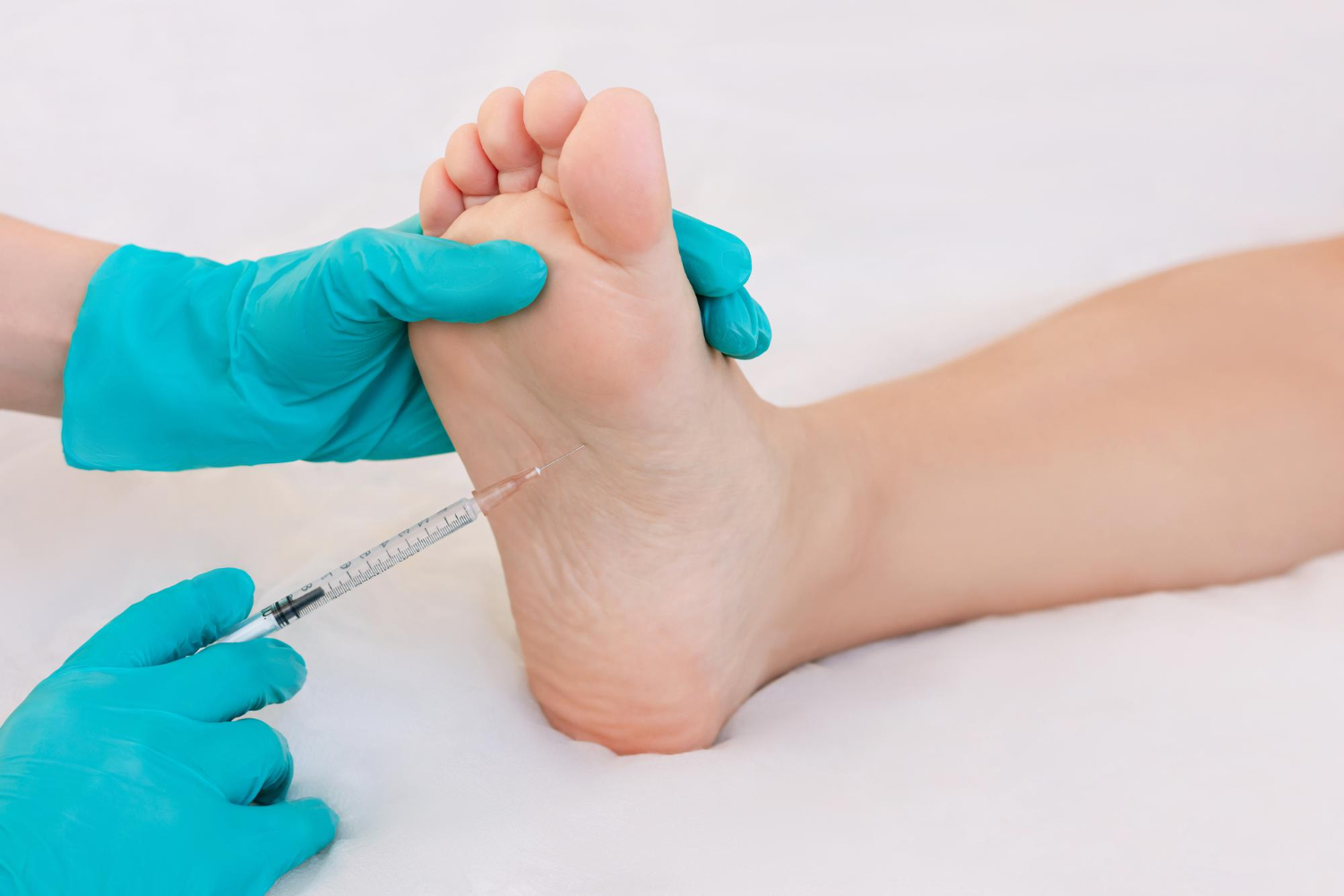9 Foot & Ankle Conditions Treated with Cortisone Injections

Foot and ankle problems are common and can significantly impact our daily lives, affecting our ability to walk, exercise, or stand comfortably. Our podiatrists at Teton Foot and Ankle specialize in diagnosing and treating a wide range of foot and ankle conditions, often utilizing cortisone injections as part of their comprehensive treatment.
What Are Cortisone Injections?
A cortisone injection is a highly targeted treatment delivering corticosteroid medication directly into an inflamed area, such as a joint or soft tissue in the foot or ankle. Cortisone injections are widely used as an anti-inflammatory therapy to reduce pain, swelling, and stiffness, resulting in improved mobility and function as well as a reduction in pain.
The injection is typically administered using a fine needle and may be guided by ultrasound to ensure accuracy. A local anesthetic may also be used to minimize discomfort. While injections can be repeated, most providers recommend limiting the frequency to avoid weakening the tissue.
Most patients experience relief within a week, with the effects lasting anywhere from six weeks to six months, depending on the condition and the individual’s response to the injections. While cortisone injections do not provide permanent pain relief, they can offer a vital opportunity for rehabilitation and recovery to prevent long-term negative effects.
Although risks are uncommon, they can include:
- Temporary pain flare-ups
- Skin changes
- Infection or weakening of the tissue
A podiatrist can help you weigh up the benefits and risks to determine if cortisone injections are appropriate for you.
10 Foot and Ankle Conditions Treated With Cortisone Injections
Ankle ligament sprain
An ankle ligament sprain often results from twisting or rolling the ankle. Symptoms include swelling, bruising, as well as instability and pain on the outer ankle.
Cortisone helps by reducing the inflammation and pain, offering a valuable window of time for effective rehabilitation. Alongside cortisone treatment, a podiatrist may recommend bracing the ankle or gentle range-of-motion exercises to prevent the injury from happening again.
Ankle osteoarthritis
This degenerative joint disease causes cartilage breakdown in the ankle and often arises from aging or previous injuries. Symptoms include swelling, stiffness, reduced range of motion, and pain. Cortisone helps by relieving the pain and swelling, allowing improved mobility and the opportunity to participate in physical therapy to reduce negative aftereffects.
Bunion
A bunion is a bony bump at the base of the big toe, causing joint misalignment. Causes range from genetics to tight footwear and can result in limited joint motion, redness, and swelling. Cortisone injections can reduce pain and swelling, particularly when other measures like shoe modifications are not helping.
Bursitis
Bursae are fluid-filled sacs that cushion joints and tendons. Bursitis is an inflammation of the bursa that can occur due to overuse, pressure, or trauma, resulting in swelling, warmth, and pain near the affected joints. A direct cortisone injection into the bursa quickly reduces inflammation and pain.
Gout
Gout is a type of arthritis caused by the buildup of uric acid crystals in the joints, resulting in sudden, severe pain, redness, and swelling, typically in the big toe. Cortisone helps by rapidly decreasing inflammation during acute gout attacks, providing relief from the symptoms.
Managing gout in the long term involves addressing dietary triggers such as red meat and alcohol, and staying hydrated to reduce uric acid buildup.
Morton's neuroma
Morton’s neuroma is a thickening of tissue around a nerve in the ball of the foot, often between the third and fourth toes, causing numbness, burning pain, or the sensation of a pebble in the shoe. Cortisone injections decrease nerve inflammation and alleviate the pain.
Plantar fasciitis
Plantar fasciitis is the inflammation of the plantar fascia, the ligament connecting the heel to the toes. This condition is caused by overuse, flat feet, or obesity, and can cause stabbing heel pain, particularly in the morning.
Cortisone injections target the inflamed area, offering rapid pain relief and high success rates. Injections, along with custom orthotics and daily calf stretches, can provide long-term support, helping to prevent flare-ups and promote healing.
Posterior tibial tendonitis
This is an inflammation of the posterior tibial tendon, which supports the arch of the foot, and is often caused by flat feet and overuse. The results in pain along the inner ankle and arch collapse. Cortisone injections reduce tendon inflammation, alleviating the pain.
Rheumatoid arthritis
Cortisone injections can also be used to treat rheumatoid arthritis, an autoimmune disorder causing chronic joint inflammation, including in the feet and ankles. The immune system attacks the joint lining, resulting in pain, swelling, stiffness, and even deformity. Injections of cortisone control local inflammation and pain, improving overall function and quality of life.
Tarsal tunnel syndrome
Tarsal tunnel syndrome involves compression of the posterior tibial nerve as it passes through the tarsal tunnel near the ankle. The syndrome often causes injury, swelling, burning, tingling, or numbness on the inside of the ankle and foot. Cortisone reduces nerve inflammation and swelling, potentially relieving symptoms and preventing further nerve damage.
Are Cortisone Injections Right for You?
Cortisone injections are one of many strategies to manage foot and ankle conditions. Straightforward treatments such as rest, physical therapy, changes to footwear, and medication may be tried first, but cortisone injections can be a very helpful next step, particularly when pain limits your ability to participate in daily activities or rehabilitation practices.
A podiatrist will first assess your condition and medical history before determining if cortisone injections are the best option for you.
Schedule an Appointment With a Podiatrist in Idaho Falls
If you are struggling with persistent foot or ankle pain, our expert team at Teton Foot and Ankle can help determine if cortisone injections or another course of treatment is right for you.
Our friendly team is here to guide you through all of your options and help you receive treatment. Booking is simple, and treating an issue early can make a difference in the quality of your life and in preventing long-term issues.
Contact us to schedule an appointment.
Get in touch!
Call our office if you have any questions about what we do or to schedule an appointment.
